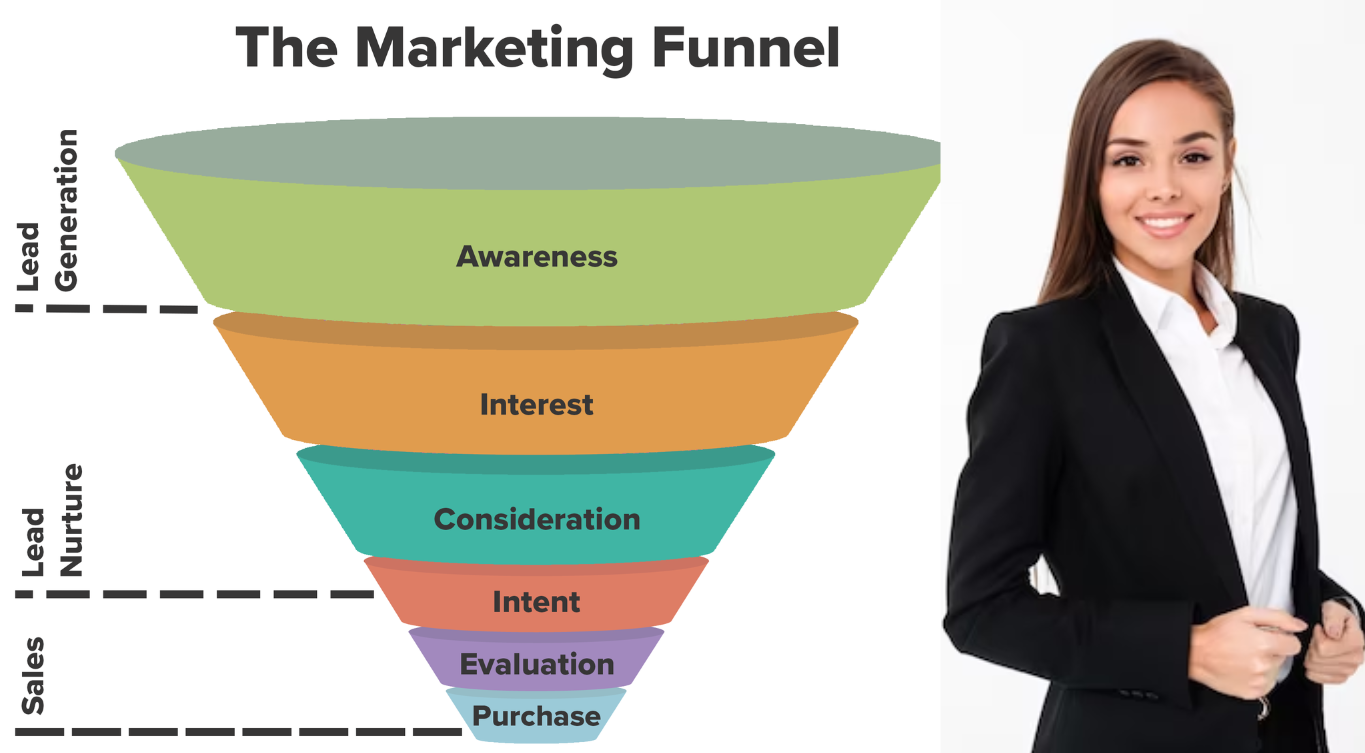The Sales Funnel Explained: Turning Clicks into Customers
To understand the concept of the sales funnel in digital marketing field read this blog to the end. The funnel is a strategic approach that guides potential customers through a series of steps, gradually narrowing down their choices until they take action.
 Calling all aspiring business boosters! Despite popular belief, making money online really is as easy as it is made out to be, and this blog intends to explain how! We will be exploring the topic of the Marketing Funnell, explaining how you can implement it and turn your affiliate marketing journey into passive income. By understanding and building a strong funnel, you can transform those random clicks into loyal customers who buy through your affiliate links. If you’re new to this process, fear not! The process is broken down into simple terms, helping you to utilise this tool for yourself, no matter your level. By the end of this blog, you will understand not only what market funnelling is, but also how to wield its power for maximum success.
Calling all aspiring business boosters! Despite popular belief, making money online really is as easy as it is made out to be, and this blog intends to explain how! We will be exploring the topic of the Marketing Funnell, explaining how you can implement it and turn your affiliate marketing journey into passive income. By understanding and building a strong funnel, you can transform those random clicks into loyal customers who buy through your affiliate links. If you’re new to this process, fear not! The process is broken down into simple terms, helping you to utilise this tool for yourself, no matter your level. By the end of this blog, you will understand not only what market funnelling is, but also how to wield its power for maximum success.
The sales funnel is also referred to as a landing page, optin page or sales page. It is used a a toll to gather email addresses to help grow your all important email list.
What is the Sales Funnell?
Firstly, imagine a funnel – wide at the top and narrow at the bottom. Now, let’s apply this concept to marketing. The sales funnel is a strategic approach that guides potential customers through a series of steps, gradually narrowing down their choices until they take the desired action – whether it’s making a purchase, signing up for a newsletter, or any other goal you have in mind.
In simpler terms, the funnel is like a friendly guide leading your audience from curiosity to commitment.
It also helps to understand your audience’s needs and present the right offer at the right time. This personalised approach creates happier customers which, in turn, creates more commissions for you!
Each stage of the funnel serves a specific purpose, creating a seamless journey for your potential customers.
The Market Funnel Stages:

Stage 1: Awareness
At the wide opening of the funnel, your goal is to market your target audience aware of your product or service.
This is where engaging content, social media presence, and advertisements come into play.
You want to capture attention and pique curiosity, enticing potential customers to explore further and give you their valuable email address.
Stage 2: Interest
As your audience moves down the funnel, they enter the interest stage.
Here, you provide more detailed information, showcasing the value of your offering.
Blog posters, informative videos, and free resources can help build trust and establish your authority in the niche.
The goal is to keep their interest alive and encourage them to learn more.
Stage 3: Consideration
Now you’ve got their curiosity piqued, it’s time to highlight the unique benefits of your product of service.
Offer tutorials, customer testimonials, and comparisons with competitors.
This is the stage where you address potential concerns and provide reassurance, guiding them towards a favourable decision – you.
Stage 4: Conversion
The narrowest part of the funnel is where THE click happens.
Here, your audience is ready to take action.
Whether it’s making a purchase, signing up for a trial, or subscribing to your newsletter, the goal is to make it easy for them to say ‘yes’.
Streamlined processes, limited-time offers, and irresistible incentives can tip the scales in your favour and end in a sale.
Building Your Sales With Your Funnel:

Know Your Audience
Understanding your target audience is the cornerstone of effective marketing.
Who are they?
What are their pain points and their dreams?
What solutions are they seeking?
The more you know, the more relatable you can make your content to resonate with their needs and aspirations.
Create Compelling Content
Craft content that not only captures attention but also provides value.
Blog posts, social media updates, and videos should align with your audience’s interests and address their concerns.
Make sure you know what social media platforms your audience is using and focus your resources accordingly.
Quality content builds trust and keeps them moving through the funnel.
Utilize Lead Magnets
In the interest stage, entice your audience with lead magnets – free resources like ebooks, guides, or webinars.
By offering something valuable in exchange for their contact information, you can continue nurturing the relationship and guiding them through the funnel.
Track Your Audience
Not all leads are the same.
Use analytics tools to see what’s working and what’s flopping.
Tweak your funnel based on these insights to keep those conversions flowing.
Segment your audience based on their behaviours, preferences, and interactions with your content.
This allows you to tailor your approach, providing a more personalised and effective experience.
Optimize for Conversions
At the bottom of the funnel, remove any friction that might hinder conversions.
Simplify the buying process, offer clear calls-to-action, and provide assurances like money-back guarantees or trial periods.
The easier it is for your audience to take the desired action, the higher your conversion rates will be.
Be Patient
Building a successful funnel takes time and effort. Don’t get discouraged by slow results.
The Importance of a Funnel in Affiliate Marketing:

Maximising ROI:
The sales funnel process is not just about attracting traffic; it’s about converting that traffic into revenue.
They enable you to target the right people, saving you from wasting time and money on irrelevant clicks.
By guiding your audience through a carefully crafted funnel, you maximise your return on investment (ROI) by ensuring that your marketing efforts translate into tangible results.
Building Long-Term Relationships:
A well-designed funnel fosters trust and engagement.
By providing value at each stage, you’re turning casual browsers into informed buyers and laying the foundation for long-term relationships.
Repeat customers and brand loyalty are invaluable in the world of affiliate marketing.
Understanding Customer Behavior:
The funnel isn’t just a one-way street – it’s a feedback loop.
Analysing how your audience interacts with each stage provides valuable insights into their behaviour.
This data allows you to refine your strategies, optimise your funnel, and stay ahead of changing market dynamics.
Differentiating in a Crowded Market:
With countless options available to consumers, standing out is crucial.
A well-crafted funnel sets you apart by offering a unique and tailored experience.
It’s not just about selling a product; it’s about creating a memorable journey that resonates with your audience.
Use different funnels to promote various products, increase personalisation and maximise your earning potential.
Conclusion on the Sales Funnel
Congratulations! You’re now armed with the secrets of the sales funnel and its use in affiliate marketing. Use your newly gained tools to guide your audience seamlessly from curiosity to commitment, turning casual visitors into loyal customers.
Remember, the key lies in understanding your audience, creating compelling content, and optimising your funnel for maximum impact. But don’t forget to inject your personality into this funnel – people connect with people, not funnels.
Now, go out there and build your funnelling empire! Transform your affiliate marketing journey into a thrilling success and turn those clicks into customers.
Do you need an easy to use funnel with all the templates ready to go and free training – you cane get it here.


